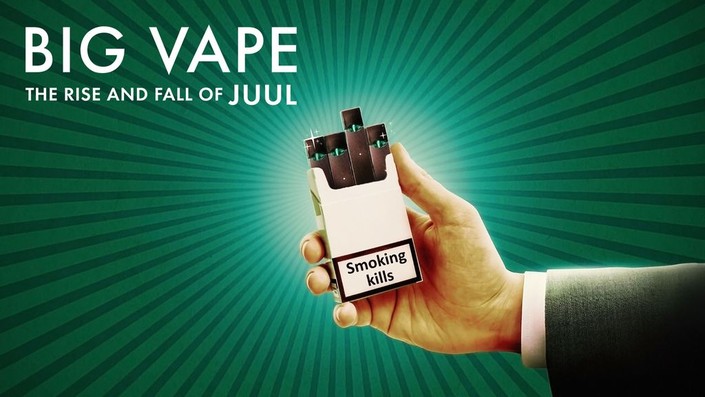WARNING: This product contains nicotine. Nicotine is an addictive chemical.
Vaping, once hailed as the hip and healthier alternative to smoking, had a shining star: Juul. Juul was the e-cigarette that seemed to be in every young adult’s hand, every influencer’s post, and, unfortunately, in every school’s restroom. But how did Juul go from being the Apple of vaping to the Titanic of tobacco alternatives? Grab your popcorn as we dive into the rollercoaster tale of Juul’s meteoric rise and catastrophic fall. It’s a story filled with innovation, controversy, and more twists than a daytime soap opera.
Back in the days when “vaping” wasn’t yet a household word, two Stanford graduates, James Monsees and Adam Bowen, had a dream: to create a sleek, tech-savvy alternative to traditional cigarettes. They envisioned something so cool and convenient that even the Marlboro Man would tip his hat in approval. Enter Juul in 2015, with its USB-stick design and a variety of flavors that sounded more like dessert menus than nicotine delivery systems. From Crème Brûlée to Mango, Juul was an instant hit. It was like the iPhone launch but for smokers.
Juul’s rise was nothing short of phenomenal. Social media was flooded with hashtags and selfies featuring the stylish little device. Celebrities and influencers vaped in slow motion, their followers scrambling to get a taste of the trendy tech. Juul’s marketing was slick, targeting millennials and Gen Z with the promise of being part of the “cool crowd” while kicking the cigarette habit. Sales skyrocketed, and by 2018, Juul controlled over 70% of the e-cigarette market. It was like watching a startup turn into a unicorn, only this unicorn puffed out fruity clouds of vapor.

As Juul’s popularity soared, so did the scrutiny. Health experts began to raise alarms about the potential risks of vaping, particularly among teenagers. It turned out that the same sleek, enticing design that made Juul so popular was also making it dangerously appealing to kids. Schools reported a spike in vaping among students, with Juul becoming so ubiquitous it earned the nickname “the iPhone of e-cigarettes.” The FDA and CDC started investigating, and the news wasn’t good. Reports of lung injuries and nicotine addiction among young users cast a dark shadow over Juul’s shiny image.
Juul’s downfall accelerated with the controversy over flavored e-cigarettes. While adults might have appreciated a nicotine hit that tasted like mint or mango, it was a siren song for teens. The backlash was swift and fierce. Parents, educators, and lawmakers demanded action, leading to a ban on flavored e-cigarettes. Juul, in an attempt to salvage its reputation, voluntarily pulled most of its flavors from the market. But the damage was done. Juul had become the poster child for youth vaping, and no amount of PR spin could change that.
If Juul thought they could vape through the storm, they were sorely mistaken. Lawsuits began piling up like unsent Christmas cards. Parents sued for misleading marketing that targeted their kids. States sued for public health costs. Even former employees joined the fray, alleging shady practices and whistleblowing on internal documents. Juul was suddenly facing a legal onslaught from all sides, and their once-flawless reputation was now smeared with scandal.
As if the lawsuits weren’t enough, the government stepped in with regulations that hit Juul where it hurt. The FDA tightened its grip, demanding that Juul prove its products were safe and effective for quitting smoking—a tall order for a company already drowning in controversy. Congress got involved too, grilling Juul executives in hearings that felt more like reality TV drama than public service. Juul’s market share plummeted, and their ambitious plans for global domination fizzled out faster than you can say “nicotine addiction.”

By the time the dust settled, Juul was a shadow of its former self. The company that once aimed to revolutionize smoking had become a cautionary tale. Sales tanked, and executives jumped ship like it was the Titanic. The sleek, high-tech image was replaced by one of corporate greed and irresponsibility. Juul’s attempt to reinvent itself came too late, and the vaping giant that had once soared so high now struggled to stay afloat.
So, what can we learn from the rise and fall of Juul? For one, innovation without consideration of social impact can lead to disaster. Juul’s story is a reminder that even the coolest tech can have a dark side. The vaping industry continues to evolve, with new regulations and players entering the market. But the shadow of Juul’s mistakes looms large. As the saying goes, those who don’t learn from history are doomed to repeat it. Let’s hope the next wave of vaping innovation takes this lesson to heart and puffs a little more cautiously.
Juul’s journey, as highlighted in “Big Vape: The Rise and Fall of Juul,” is a classic tale of rapid ascent and equally swift decline. Founded by two Stanford graduates, Juul revolutionized the vaping industry with its sleek design and appealing flavors, quickly dominating the market. However, this success came at a cost, as health concerns and accusations of targeting minors led to widespread backlash. Legal battles and stringent regulatory scrutiny followed, tarnishing Juul’s image and reducing its market share dramatically. Ultimately, Juul’s story underscores the importance of balancing innovation with social responsibility, offering a stark lesson for future ventures in the vaping industry.
1. What made Juul so popular initially?
Juul became popular primarily due to its sleek, modern design and a variety of enticing flavors like mango and crème brûlée. The device was easy to use, resembling a USB stick, which made it both discreet and trendy among young adults and teenagers. Additionally, Juul’s marketing strategies cleverly targeted millennials and Gen Z, positioning the product as a stylish, tech-savvy alternative to traditional smoking.
2. Why did Juul face so much backlash?
Juul faced significant backlash because its products became highly popular among teenagers, leading to concerns about underage vaping and nicotine addiction. The flavors that appealed to young users and aggressive marketing tactics drew criticism from parents, educators, and health officials. Reports of health issues related to vaping, such as lung injuries, further fueled the controversy, prompting regulatory scrutiny and legal actions against the company.
3. How did regulatory changes impact Juul?
Regulatory changes had a profound impact on Juul. The FDA imposed stricter regulations on e-cigarettes, demanding that Juul prove its products were safe and effective for smoking cessation. Additionally, the government banned flavored e-cigarettes, which were a significant part of Juul’s appeal. These regulations, combined with mounting lawsuits and negative public perception, led to a drastic decline in Juul’s market share and reputation.
4. What were the legal challenges faced by Juul?
Juul faced numerous legal challenges, including lawsuits from parents claiming the company targeted their children, states suing for public health costs, and former employees alleging unethical practices. These legal battles created a significant financial and reputational burden for Juul, further compounding the issues caused by regulatory crackdowns and public health concerns.
5. What lessons can be learned from Juul’s rise and fall?
The rise and fall of Juul offer important lessons about balancing innovation with social responsibility. While Juul’s innovative design and marketing propelled it to success, the lack of consideration for potential health impacts and societal consequences led to its downfall. Future ventures in the vaping industry, and tech innovation in general, should prioritize ethical practices and the well-being of users to avoid similar pitfalls.
If you want to know more, please refer to this article:
